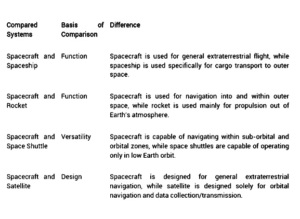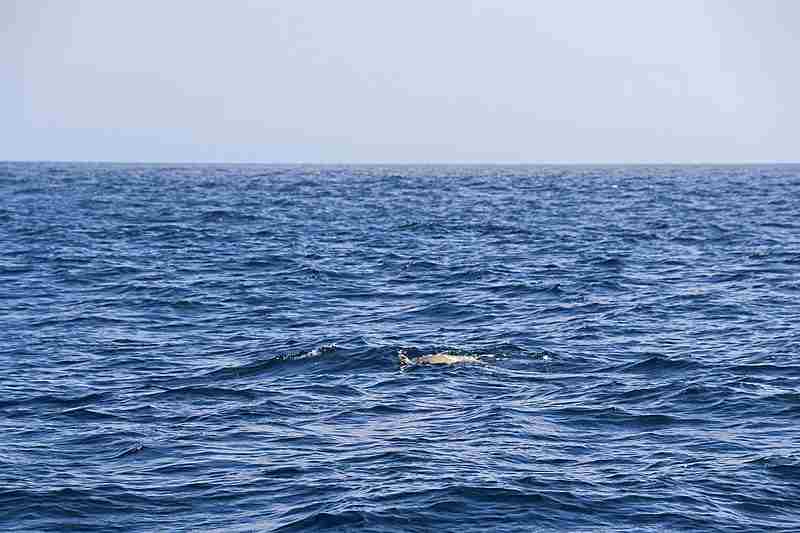9 Types of Space Exploration and Their Characteristics
Types of space exploration are; manned, unmanned, interplanetary, orbital, sub-orbital, flyby, surface, deep and shallow exploration. They are classified based on human interference, destination, kinetics, and complexity.
This article discusses the types of space exploration and their characteristics, as outlined below;
-Types of Space Exploration based on Human Interference
-Types of Space Exploration based on Destination
-Types of Space Exploration based on Kinetics
-Types of Space Exploration based on Complexity
-Types of Space Exploration based on Human Interference
1). Manned Exploration (as one of the Types of Space Exploration)
Manned space exploration (also called ‘human space exploration’) is a type of space exploration that is conducted and operated by humans.
It is carried out using manned spacecrafts that are designed to require human operation. These crafts are usually composed of more sophisticated technology than that which is found in unmanned, autonomous crafts.
The history of manned space exploration can be traced back to 1961, when Soviet cosmonaut Yuri Gagarin traveled to outer space aboard the Vostok 1 spacecraft [11].
This has been followed by several other manned space exploration projects, such as the Apollo project that led to the first human landing on the Moon in 1969 [7]. Various manned spacecrafts have been used for extraterrestrial missions over the last few decades, including Atlantis, Columbia, Endeavor, and Challenger crafts.
The twenty-first century has seen a major rise in the popularity of manned space exploration, with the advent of space tourism among private companies.
Manned space exploration has the significant advantage of being more elaborate than unmanned exploration. One of the obvious benefits of space exploration using this approach, is the ability to collect more relevant data, and perform more decisive tasks while in space.
However, the presence of humans aboard space vessels has some limitations and disadvantages as well.
One of the limitations of manned space exploration is the restricted tolerance of humans in space. Because of the harsh and un-adaptable conditions, such projects are not applicable to collect data or carry out other functions in certain parts of space.
Another major problem is the safety challenges involved. Unlike unmanned space missions, any accident or flaw in a manned space mission can lead to loss of lives. Examples of such scenarios include the Challenger and Columbia disasters of 1986 and 2003 respectively [8].

2). Unmanned Exploration
Unmanned (or ‘un-crewed’) exploration is cheaper, safer for humans, and more commonly utilized than manned space exploration.
It basically involves the use of technologies driven by artificial intelligence and robotics, to conduct autonomous expeditions in space [12].
An advantage of this approach is that it helps to unify and advance multiple disciplines. The quest to improve autonomous space technologies has led to innovations in smart house technology, artificial intelligence algorithms, and robotics design among others.
At the same time, unmanned space exploration projects have created avenues for workers from these various fields to collaborate and share ideas. Such a trend is ideal for the achievement of sustainable development.
Unmanned space exploration also has the advantage of enabling humans to gather information and carry out operations in deep, remote regions of space. It is by the use of robotic space systems that we have gained knowledge about the harshest zones, remote resources and large-scale processes of the universe.
A very common use of unmanned space facilities is satellite installation. Geographic monitoring has been made possible in real-time, and rapid data sharing has also been enabled by such satellites.
Unmanned space exploration does not always require spacecrafts. The Kepler space telescope launched in 2009 by NASA [2], is an example of an unmanned space expedition. It was used to make important observations of extrasolar planets (or ‘exoplanets’) till its retirement in 2018.
Space probes that have been utilized in unmanned space operations include Voyager 1 and Voyager 2; which were launched into orbit by NASA, in 1977 [3].
-Types of Space Exploration based on Destination
3). Interplanetary Exploration (as one of the Types of Space Exploration)
Interplanetary space exploration is a type of space exploration whose aim is to investigate the intermediate zones between planetary bodies [1].
This includes the asteroid belt, and parts of outer space that are dominated by interstellar dust particles.
Manned or unmanned methods can be used for interplanetary space exploration. Because the destination is interplanetary zones, this type of exploration is usually restricted to a defined solar or planetary system.
The obvious limitation of interplanetary space exploration is its restriction to a relatively small part of outer space. However, it has some advantages.
By investigating interplanetary zones, important data can be gathered, with respect to the history, processes and features of the universe.
The small details which can be investigated during interplanetary missions, may not be noticeable by other means. Many of the hypotheses about the origin of the universe have been evaluated for credibility using data collected for interplanetary zones.
The discovery of extraterrestrial mineral deposits has also been supported by interplanetary space exploration. This includes large deposits of gold in rocky asteroid masses [4].
4). Orbital Exploration
Orbital exploration is the propulsion of space technologies into the planetary orbit of our solar system.
It is one of the earliest types of space exploration, and can be traced back to 1957 with the unmanned launch of Sputnik 1 satellite [10].
Manned orbital space exploration commenced in the twentieth century as well, with the outer space mission of Yuri Gagarin in 1961, as well as that of American cosmonaut Alan Shepard in the same year [9].
The type of spacecraft used for such exploration missions is called an ‘orbiter spacecraft’ and is exemplified by the Galileo spacecraft launched in 1995 [13].
Orbital space exploration is more demanding than sub-orbital exploration, due to the need to overcome a larger amount of gravitational force in order to enter into orbit. To provide the propulsion needed, efficient nuclear, liquid hydrogen and fuel cell systems are required.
5). Sub-Orbital Exploration
Sub-orbital space exploration is the launching of space technologies beyond the atmosphere, but not into the planetary orbit.
This type of exploration is carried out with less propulsion power and less velocity than orbital exploration, and as a result, the spacecraft does not attain ‘orbital velocity’, which would align its trajectory with the direction of the orbit.
Sub-orbital flight systems generally require less sophistication and energy than orbital flights.
The drawback of sub-orbital exploration is its limited exposure. It is not suitable for in-depth investigation purposes, and has been of more relevance for smaller tasks like test projects and space tourism expeditions.
Ballistic craft design and military infrastructure have been improved in the context of sub-orbital exploration.
-Types of Space Exploration based on Kinetics
6). Flyby Exploration (as one of the Types of Space Exploration)
Flyby exploration is a type of space exploration that is focused on gathering instantaneous information about the solar system and outer space [5].
A common goal of flyby missions is preliminary assessment or reconnaissance survey of outer space. Because they involve technologies that are relatively cheap and simple, such missions help to pave the way for more elaborate space projects.
As already implied, flyby exploration is carried out using flyby spacecrafts. They are less-complex than other spacecrafts, and equipped with components for visual data collection.
During flyby space missions, the craft does not navigate within the orbit of any planetary body. Instead, it follows an extra-orbital path or solar orbit.
This mode of navigation enables the craft to move past multiple planets and interplanetary zones, and observe them from a distance.
Flyby space exploration may be manned or unmanned, and dates back to the 1960s with the launch of Mariner spacecrafts on separate missions.
The drawback of this type of space exploration is its data collection unreliability compared to other types.

7). Surface Exploration
Surface exploration is the exploration of bodies in outer space using terrestrial navigation mechanisms.
In order to carry out this type of exploration, lander spacecrafts are used. These crafts are equipped to land on extraterrestrial planetary surfaces.
Landers are often used to transport rover crafts, which are terrestrial navigation crafts that can be used for observatory studies on planets.
Examples of rover crafts include the Mars Rover which landed on the surface of Mars in 1997, as part of the Pathfinder space mission [6].
The advantage of surface exploration is its use for in-depth study, due to the terrestrial, in-situ kinetics of rover crafts. However, such missions are very expensive, typically costing billions of dollars.

-Types of Space Exploration based on Complexity
8). Deep Exploration (as one of the Types of Space Exploration)
Deep space exploration is the investigation of outer space features in regions beyond the Moon’s orbit [14].
These regions are collectively called the ‘deep space’ and include other planets in our solar system, and extrasolar regions.
Deep space technology unifies astronomy, aviation technology, astronautics, artificial intelligence and aeronautics, to produce suitable equipment for space exploration.
Several communication satellites have been deployed in the course of deep space missions, and important data that can be useful for space colonization, ecosystem assessment and habitat expansion has also been collected through deep space exploration.
9). Shallow Exploration
Shallow space exploration is a geographically restricted type of exploration that does not generally exceed the Earth’s orbit.
It is limited to what can be described as the ‘shallow space’ zone. Shallow space exploration is most useful for purposes of observation, and may also be carried out using telescopes.
Another perspective on shallow exploration is the ‘shallow-earth’ exploration which involves the study of earth materials (soil, rock) and water samples at shallow depth, on extraterrestrial planets. This is linked to surface exploration, and can be achieved using rovers and landers.
Conclusion
Types of space exploration are;
1. Manned Exploration
2. Unmanned Exploration
3. Interplanetary Exploration
4. Orbital Exploration
5. Sub-Orbital Exploration
6. Flyby Exploration
7. Surface Exploration
8. Deep Exploration
9. Shallow Exploration
They are classified based on human interference, destination, kinetics and complexity.
References
1). Agrawal, P. C.; Sreekantan, B. V.; Bhandari, N. (2007). “Space astronomy and interplanetary exploration.” Current Science 93(12). Available at: https://www.researchgate.net/publication/255616520_Space_astronomy_and_interplanetary_exploration. (Accessed 1 September 2022).
2). Borucki, W. J.; Koch, D. G.; Basri, G.; Caldwell, D. A.; Caldwell, J. F.; Cochran, W. D.; Devore, E.; Dunham, E. W.; Geary, J.; Gilliland, R. L.; Gould, A.; Jenkins, J. M.; Kondo, Y.; Latham, D. W.; Lissauer, J. J. (2003). “The Kepler Mission: Finding the Sizes, Orbits and Frequencies of Earth-size and Larger Extrasolar Planets.” Available at: https://www.researchgate.net/publication/234484688_The_Kepler_Mission_Finding_the_Sizes_Orbits_and_Frequencies_of_Earth-size_and_Larger_Extrasolar_Planets. (Accessed 1 August 2022).
3). Broadfoot, A. L.; Sandel, B. R.; Shemansky, D.; Smiith, G. R.; Holberg, J. B.; Smith, G. R.; Holberg, J. B.; Mcconnell, J. C.; Atreya, S. K.; Donahue, T. M.; Strobel, D. F.; Bertaux, J. (1981). “Overview of the Voyager ultraviolet spectrometry results through Jupiter encounter.” Journal of Geophysical Research Atmospheres 86(A10). Available at: https://doi.org/10.1029/JA086iA10p08259. (Accessed 1 September 2022).
4). Feinman, M. (2014). “Mining the Final Frontier: Keeping Earth’s Asteroid Mining Ventures from Becoming the Next Gold Rush.” Pittsburgh Journal of Technology Law and Policy 14(2):202. Available at: https://doi.org/10.5195/tlp.2014.140. (Accessed 1 August 2022).
5). Fuchs, T. J.; Thompson, D. R.; Bue, B.; Castillo-Rogez, J. C.; Chien, S. A.; Gharibian, D.; Wagstaff, K. L. (2015). “Enhanced Flyby Science with Onboard Computer Vision: Tracking and Surface Feature Detection at Small Bodies.” Earth and Space Science 2(10):n/a-n/a. Available at: https://doi.org/10.1002/2014EA000042. (Accessed 1 September 2022).
6). Golombek, M. P.; Cook, R. A.; Economou, T. E.; Folkner, W. M.; Haldemann, A. F.; Kallemeyn, P. H.; Knudsen, J. M.; Manning, R. M.; Moore, H. J.; Parker, T. J.; Reider, R.; Schofield, J. T.; Smith, P.; Vaughan, R. M. (1998). “Overview of the Mars Pathfinder Mission and Assessment of Landing Site Predictions.” Science 278(5344):1743-8. Available at: https://doi.org/10.1126/science.278.5344.1743. (Accessed 1 September 2022).
7). Gupta, N. (2019). “APOLLO 11.” International Journal of Advanced Research. Available at: https://www.researchgate.net/publication/334536236_APOLLO_11. (Accessed 1 September 2022).
8). Hall, J. L. (2003). “Columbia and Challenger: Organizational failure at NASA.” Space Policy 19(4):239-247. Available at: https://doi.org/10.1016/j.spacepol.2003.08.013. (Accessed 1 September 2022).
9). Hollins, H. (2013). “Forgotten hardware: How to urinate in a spacesuit.” AJP Advances in Physiology Education 37(2):123-128. Available at: https://doi.org/10.1152/advan.00175.2012. (Accessed 1 September 2022).
10). Kuznetsov, V. D.; Sinelnikov, V. M.; Alpert, S. (2014). “Sputnik 1 and the First Satellite Ionospheric Experiment.” XXXX COSPAR, August 2-10, 2014. Available at: https://doi.org/10.13140/RG.2.2.30044.59524. (Accessed 1 September 2022).
11). Moore, D. (2022). “Science in Space: biology in zero gravity.” Available at: https://www.researchgate.net/publication/360614300_Science_in_Space_biology_in_zero_gravity. (Accessed 1 September 2022).
12). Russo, A.; Lax, G. (2022). “Using Artificial Intelligence for Space Challenges: A Survey.” Applied Sciences 12(10):5106. Available at: https://doi.org/10.3390/app12105106. (Accessed 1 September 2022).
13). Showstack, R. (2000). “Galileo spacecraft returns stunning findings about Io.” Eos Transactions American Geophysical Union 81(1):1-1. Available at: https://doi.org/10.1029/00EO00002. (Accessed 1 September 2022).
14). Wu, W.; Liu, W.; Qiao, D.; Jie, D. (2012). “Investigation on the development of deep space exploration.” Science China Technological Sciences 55(4). Available at: https://doi.org/10.1007/s11431-012-4759-z. (Accessed 1 September 2022).








